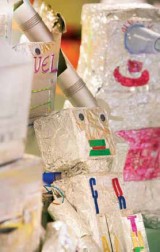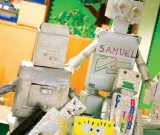Jenny Monk and Cathy Silman investigate the success of a robot building challenge
The role of the primary school teacher is to place active learning at the heart of the curriculum, or so say Jenny Monk and Cathy Silman, authors of Active Learning in Primary Classrooms (Pearson Education Limited, 2011). It’s their belief that by making learning active, teachers can nurture curiosity, encourage cooperation and develop the skills, knowledge and experiences that enable children to play a full and fruitful role in society.
However, the authors also emphasise that active learning does not have to involve physical action. Listening to a story that engages the imagination; reading silently with enjoyment; carefully studying a plan before making a model; or listening to music are all essential parts of the curriculum experience.
The book’s premise is that, ideally, children choose to learn, not just because they want to please an adult, or merely because it sounds fun, but because they are genuinely interested in the subject matter. If children can be presented with problems they really want to solve and need to learn something new in order to do so, active learning will naturally follow. Eventually, the ethos of the class will evolve so that most tasks are seen as relevant, even revising for SATs.
In their book, Jenny Monk and Cathy Silman provide a number of detailed case studies that include exciting, practical models of planning and teaching with reflections from both teachers and children. The following example, taken from Active Learning in Primary Classrooms, charts the development of a topic at Brookside Primary School in Bicester that helped children to gain an understanding of control through investigating simple pneumatic systems and designing and making a robot.
To begin with, the teachers wanted a ‘hook’ to grab the children’s attention and decided to place one child in a foilcovered box - with holes cut out for head, arms and legs - out of the sight of other children. The child entered the classroom and began to talk in a robotic voice and to move robotically. The children were asked to focus on some key questions:
• What is a robot?
• Where does the word ‘robot’ come from?
True or false sheets were completed and the children compared their understanding with a partner. The teacher then provided some factual information and as this was given, children wrote questions on postit notes, which were then stuck onto the robot’s body. The answers to their questions would, the teachers hoped, be provided by the children’s research.
A discussion followed about the boring jobs that some robots were now capable of doing and children considered why robots might be suited to these tasks, i.e. their limitless energy, speed and accuracy, and lack of feelings. They then considered the disadvantages: unemployment, for example. Next the children watched video footage of robots conducting an orchestra, hoovering and even playing football.
The children also watched a clip from Star Wars where numerous robots were moving around. They noted down aspects of shape and purpose and added this information to their thoughts on designs.
A design technology lesson followed in which the children looked at films of existing robots - a cleaner and a grass cutter - and considered why these were the first available (lots of appropriate robot clips can be found on YouTube). Comparison was made with the class Roamer and consideration taken of logistics such as stairs and tidying away, which would be more challenging.
The children discussed what changes could happen in their lifetimes and talked about what they would like available in 2050 - with some interesting results!
 The following six lessons were devoted to the achievement of a series objectives:
The following six lessons were devoted to the achievement of a series objectives:
• using the power of creative ideas to solve problems and explore ideas;
• observing and exploring, taking part safely in a practical task, applying practical skills, communicating ideas and continually evaluating;
• applying knowledge in real-life contexts;
• developing practical skills; thinking creatively and testing their ideas and exploring materials.
To create a purpose and audience, the children were informed that all of their robots would be entered into an inventions competition. This would be held at the Summer Fayre where visitors would be asked to vote in a secret ballot. No names were used, as each robot was numbered. The original brief was provided as a guide. The children expressed their approval of this in discussion at the end of the project and were convinced the best robots won the prizes.
The key to the use of resources was restriction. In a large class with unlimited access to a range of construction kits, junk and adhesives, experienced teachers will know that children quickly lose sight of objectives. We would suggest that restrictions can enhance creativity, not limit it. The children were to focus on designing a robot, one that would help them in the present day. Examples included: a robot for cleaning the hamster, a robot that would tidy bedrooms, and a robot that would be a play companion.
In order to prepare for the challenge, the groups worked with a given resource, i.e. one of each different piece from the Connex kit. They sketched their designs, first thinking about the shapes and the available pieces. After 10 minutes their designs were compared and they were given free choice to add further pieces.
The children were now ready to design their own robot. Success criteria were shared with them from the beginning – their robots should:
• have a purpose/function, i.e a job that helps humans;
• be realistic for the purpose it is designed to perform, i.e. a robot vacuum cleaner should look like a vacuum cleaner;
• not be a fighting robot!
• be achievable and be constructed using junkmodelling resources only;
• include at least one moving part in the design using levers, pneumatics, wheels, etc.
At each stage in the process the children had to have the green light from their teacher before moving on. For example, when searching through the junkmodelling resources, they were only to take items that matched to parts of the design.
The children were frequently turned away, much to their puzzlement at first, but it really forced them to think about design and to stick to their plans.
Again, this will resonate with teachers who remember children simply sticking things onto models in an ad hoc fashion. This has its place in early years classrooms but progression in the use of resources is important. The making took at least two sessions.
The next challenge was to ensure one piece of the robot moved. This involved adaptation or addition after two teacher-led sessions on mechanisms.
The final challenge in relation to resources was that all original pieces of junk should be completely disguised, i.e. painted, covered, etc.
 The teacher had identified that collaboration and cooperation skills would be at the heart of this topic. In order to establish a team working atmosphere, the children first designed their own individual robot and produced a poster to persuade others to choose their design. They then presented these designs to members of their assigned group.
The teacher had identified that collaboration and cooperation skills would be at the heart of this topic. In order to establish a team working atmosphere, the children first designed their own individual robot and produced a poster to persuade others to choose their design. They then presented these designs to members of their assigned group.
The groups were chosen by the teacher and included children from the full range of experience and understanding. Children with special needs were integrated into the groups. It was a key moment in the project, and the teachers were able to observe the process and were impressed by the children’s ability to choose the most appropriate design in each case.
Once the design had been chosen, the planning and construction could begin. The teachers wanted the children to learn that designs have to be copied and so a clear record of the process has to be made. They took photographs and drew diagrams of the Connex models and worked from a diagram to construct a paper robot, learning about tabs and accuracy of drawing. This led to a new challenge being introduced: children should draw a net or layout of their robot.
 Teachers intend that children should become more independent and better able to make decisions and choices, which will result in effective learning. The teachers in this project knew their classes very well and recognised the challenges this project posed. In their opinion, the carefully planned, staged approach to the final outcome resulted in work of much greater quality and developed the skills of communication and collaboration which were central to their Jenny Monk and Cathy Silman are both experienced primary school teachers. They have taught in a variety of settings in both the primary and higher education sectors. intentions. Nevertheless, both teachers wanted to observe the children to assess their contribution and technical skills, and so letting go was important.. There were significant planned opportunities for this:
Teachers intend that children should become more independent and better able to make decisions and choices, which will result in effective learning. The teachers in this project knew their classes very well and recognised the challenges this project posed. In their opinion, the carefully planned, staged approach to the final outcome resulted in work of much greater quality and developed the skills of communication and collaboration which were central to their Jenny Monk and Cathy Silman are both experienced primary school teachers. They have taught in a variety of settings in both the primary and higher education sectors. intentions. Nevertheless, both teachers wanted to observe the children to assess their contribution and technical skills, and so letting go was important.. There were significant planned opportunities for this:
• the children’s individual presentations persuading others to accept their designs;
• the group interactions as decision-making began;
• the use of resources;
• meeting the success criteria;
• the work on the moving part;
• the evaluations.
At the end of the project both teachers identified these opportunities as vital to the overall assessments. In their opinion, the outcomes were only as good as they were because the focus had been on the children’s learning, providing boundaries within which they could be creative.
In discussion with the children, this proved to be the most challenging and probably most rewarding aspect of the work. From the children’s perspective, there are some key features of effective group work. These are:
A manageable number is three
“Three is not too big and not too little. You can combine the ideas of three people but no more. We included an idea from everyone – tracks, rollers and a jet pack.” “As team leader you can keep track of three. One of you can be collecting resources; two of you might be sticking something and you need two pairs of hands. We always voted and we took it in turns to do different things.”
A team leader is a good idea
“The team leader can listen and show the others how to combine the ideas and then either suggest a vote or give jobs to people. My group were happy for me to allocate jobs because I was fair. We took turns.”
Jenny Monk and Cathy Silman are both experienced primary school teachers. They have taught in a variety of settings in both the primary and higher education sectors.
Use coaching to turn failures into learning success
Ace-Classroom-Support
Why every child should feel at home in an art gallery
Ace-Art-And-Design
Outstanding schools: RJ Mitchell Primary
Outstanding schools
